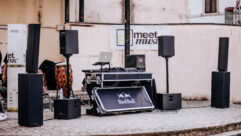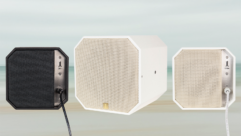
In this edition of the SVC Podcast, SVC Contributing Editor Bennett Liles talks with Robert Coggins and Mark LaBouff of FBP Systems regarding their new sound system installation at the Thorncrown Chapel. Constructed largely of glass, the building is a challenging sound environment and there had been less than successful previous attempts by others trying to provide good sound for the facility. Robert and Mark provided a Bose Panaray MA12EX system and after a few days of work, the problem was solved.
Links of interest:
- Full-service design/build AV integrator FBP Systems
- Thorncrown Chapel photo gallery
- The Bose Panaray MA12EX modular line array
Download Podcast Here:
https://s3.amazonaws.com/nb-svc/public/public/1_17_14-FBP-Systems_Thornc…
Editor’s note: For your convenience, this transcription of the podcast includes timestamps. If you are listening to the podcast and reading its accompanying transcription, you can use the timestamps to jump to any part of the audio podcast by simply dragging the slider on the podcast to the time indicated in the transcription.
Installing a sound system in a big glass house. That’s what FBP Systems was called in to do. Robert Coggins and Mark LaBouff are going to tell us how they turned around what had been a series of less-than-successful sound systems in the nearly all-glass Thorncrown Chapel. That’s coming up next on the SVC Podcast.
Robert Coggins and Mark LaBouff, thanks for joining us for the SVC Podcast from the Tulsa, Oklahoma office of FBP Systems. We’ve got a fantastic sound system installation to talk about, but first tell us about FBP Systems. What do you do there and what sort of projects do you handle?
Robert: Well, we are a design-build AV integrator and we do the full spectrum of AV projects from lighting, architectural lighting, acoustics, sound, video, broadcast video. We’re a subsidiary of the Morse Group, which consists of electrical contracting, wind farms, drywall, manufacturing automations. So we’re a small piece of the big pie.
And you’ve got one of the most remarkable and challenging projects with the Thorncrown Chapel out in the Ozarks and you only have to get one look at this place and you want to know more.
Mark: /b> It’s fantastic. You’re right.
Describe Thorncrown Chapel. If you want to see an actual glass house I think this would have to be it.
Mark: /b> It sure would. You wouldn’t want to throw any stones in this one.
How big is this place and how is it all put together?
Robert: Thorncrown Chapel, it was built in 1979, and the AIA awarded it with the gold medal in 1990 and it’s considered the fourth in the top 10 buildings of the 20th Century, so it does have some recognition. It’s got 6,000 square feet of glass and 425 windows and a flagstone floor, so needless to say, it’s quite an acoustical challenge. [Timestamp: 2:22]
Yeah, that place is just about one big window and the way that it fits into the lay of the land around it, it’s just a big glass house way out in the woods.
Robert: It sure is, and it is beautiful. It is a great view and a lot of weddings; they’re booked all year around. [Timestamp: 2:40]
Oh, I’ll bet and your pictures from whatever your event in that place would really be something. I’ve seen it described though as an acoustical nightmare, though, but you see that with a lot of churches not constructed for modern sound systems. But they had tried several times before. How were the situations with previous sound systems in there?
Robert: They basically have had three different sound systems and none of them worked. They were either unintelligible or fed back or, for whatever reason, they never worked. They were really reluctant to just take somebody’s word for it, that a system design would work in there. The architect had built two speaker enclosures and you couldn’t do anything to those enclosures. You had to leave them; you couldn’t alter them in any way. So we had to use those enclosures and we had to make it work. So obviously, no pressure. [Timestamp: 3:36]
Yeah, no pressure there coming into an environment like that. I guess they were pretty well gun-shy on people telling them they had the great solution and then having it not work quite as advertised. So that’s what you were confronted with when you came in, a little skepticism?
Robert: Yes. They were a little skeptical, but also encouraged that we were willing to step in. We did a demo for them and we set speakers at the approximate location of where they would finally rest and the demo went real well. In fact, I remember one of the – was she the owner?
Mark: She was the pastor’s mother.
Robert: The pastor’s mother, yeah.
Mark: The wife of the original builder.
Robert: Right, the wife of the original builder. She said that’s the first time that she could hear, that she could understand the speaking in the very last row ever. So the demo went real well. [Timestamp: 4:31]
You can describe it all day long but then there’s no substitute for actually hearing the sound system work but once they hear it and it sounds right, they know what they like.
Mark: You bet.
There are a zillion places for sound to bounce off of here and few places to tuck things into and behind. How did you manage to run the wiring and keep all the cabling out of sight?
Robert: Well, there was kind of a little raceway between the two enclosures, but we really didn’t have a choice. We had to use the architectural enclosures that were there in the building and we could not alter them. Fortunately, those enclosures were tall, so we said, you know, we could probably put some Panaray MA’s in there and they should just fit and they did. They just fit. But like I said, during the demo we proved that the system would work, and so after they heard it, they were really excited because they have a traditional service and they use playback tracks – and they also have piano and acoustic guitar. And those speaker locations are right behind the podium. [Timestamp: 5:43]
That could be a good and bad thing for running wiring because while you’ve got to stick with the raceways that were there and your options on where it goes would be pretty limited, it probably saved a lot of time as well.
Robert: Yeah, it sure did. All in all I think it took us three days, I believe, to complete the install and then it took – a couple of hours it took for dial up. I used EASERA and DPA sim microphones. We ran some MLS pink noise and gradually tuned that in. It didn’t require that much. Of course we used Bose’s software package to address the immediate speaker set ups and then we fine tuned it with EASERA. [Timestamp: 6:33]
Why did you choose the Bose Panaray MA12EX system for this one? Was it the features or were you already pretty familiar with how that system works?
Robert: Yes, we’ve experienced those speakers before and we know the benefit that they bring; the fact that they are great at rejecting feedback and also are going to put sound where we want sound. So it was, you know, as a line array it really worked well in there. [Timestamp: 7:03]
Yeah, I guess when you walk into a project as challenging as this one you don’t want to be bringing in a system you don’t already know the ins and outs of. That could be pretty deadly.
Robert: Absolutely. You want to remove all the variables that you can.
Had you already seen Thorncrown Chapel when they call you into the project or was it kind of a surprise when you saw it? What was the first thing you did when you got in there?
Robert: Well we knew of it. We had seen the building before. But, you know, it’s another thing to get in there and actually get to run tests and get to actually hear what’s going to happen inside the building. [Timestamp: 7:37]
And of course they’re run by the PowerMatch PM8500 amplifier. Where did you stash that? Obviously it can’t be out in the open somewhere.
Robert: We put it in the same enclosure; on the backside of that architectural enclosure as well as an analog mixer for them to plug in instruments and whatever they need to use. [Timestamp: 8:00]
I guess the PM8500 is a good amp in case you ran into anything unexpected because I think it’s fairly configurable. You’ve got an expansion slot in there for different inputs, you’ve got onboard DSP and you guys knew about all of that.
Robert: Yes. We have used that. We used that on a performing arts center. We’ve used several of those amplifiers and they’re fantastic. You can go in and configure that amplifier in a number of different ways, so if you run into a situation where you need to snag – or you need more amplification, you can immediately V-bridge the amplifier. You can convert it to a 70-volt amplifier if you need a channel that’s 70-volt. It’s very versatile and we’ve been very happy with 8500n’s.
Well, keeping on the safe side with what you know and what you’ve worked with before is the smart way to go. Thanks guys, for telling us about it. Robert Coggins and Mark LaBouff from FBP Systems and the Thorncrown Chapel. See you in part two.
Mark: You bet.










